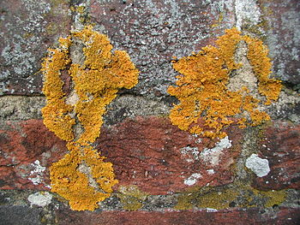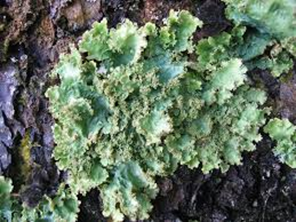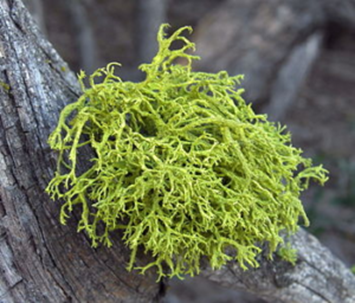Science > Biology > Classification of Microbes, Protists, and Fungi > Lichens
In the five-kingdom classification of Whittaker, there is no mention of some acellular organisms like viruses and viroids and lichens.
A lichen is a long-living composite organism that arises from algae or cyanobacteria (or both) living among filaments of a fungus in a mutually beneficial relationship (symbiotic relationship). The algal component of a lichen is known as phycobiont and the fungal component is called mycobiont.
The fungus benefits from the symbiotic relation because algae or cyanobacteria produce food by photosynthesis, which is utilized by fungus. The algae or cyanobacteria benefit by being protected from the environment by the filaments of the fungus, which absorb moisture and nutrients from the environment, and (usually) provide an anchor to it. Such relation in which both the organisms are benefited from one another is called symbiosis.
There about 400 genera and 15,000 species of lichens. They are found worldwide. They usually grow on the barks of trees, dry logs of wood, bare rocks. They are xerophytes in nature and can withstand a long period of drought.
Types of Lichens:
On the basis of fungal components:
- Ascolychens: The fungal partner belongs to Ascomycetes
- Basidiolichens: The fungal partner belongs to Basidiomycetes
- Deuterolichens: The fungal partner belongs to Deuteromycetes
On the basis of Thallus:
Crustose Lichens:

- In this case, the thallus form crust-like structure.
- It closely adheres to the substrate.
- They are found on bark or rock.
- Examples: Graphis, Lecanora, Haematomma
Foliose Lichens:

- In this case, thallus has leaf-like lobes.
- They are fixed from the substrate by hairy rhizoids like structure called rhizines.
- They are attached only at central points.
- Example: Parmellia, Collema, Peltigera
Fruticose Lichens:

- Their thalli are cylindrical ribbon-like and branched.
- It is attached only at the base by basal mucilagenous disc.
- They are commonly called as shrubby lichens.
- Examples: Cladonia, Usnea, Alectoria
Economic Importance of Lichens:
Use as Food:
- In Iceland Cetraria islandica commonly known as “Iceland moss” is grounded up and mixed with wheat flour.
- A leathery lichen Umbillicaria, commonly known as “root tripe” has been eaten by travellers in arctic regions in danger of starvation.
- Two species of Lecanora have been used as food in the barren plains and mountains of Western Asia and Northern Africa.
- Certain classes of East Siberian inhabitants use lichens as vegetable diet.
- In Tamil Nadu, a species of Parmelia known in Telugu as “rathapu” or rock flower has been used in curry preparation and is famous for its delicacy. It is also used for the preparation of chocolates and pastries.
Use as Fodder:
- Cladonia rangifera, commonly known as “reindeer moss” grows in dense tufts of up to 12 inches height in extremely cold regions. It is food for reindeer and cattle.
- Species of Cladonia, Citraria, Evernia, Parmelia are used as fodder.
Medicinal Use:
- Usnic acid obtained from the Usnea and Cladonia species is used as an antibiotic against Gram-positive bacteria.
- Peltigera canina, the dog lichen is used as medicine for hydrophobia in ancient days.
- Lobaria pulmonaria, lungwort are used for the diseases of lungs (respiratory diseases) and T.B.
- Parmelia is useful against epilepsy.
- Usnea species are good against urinary diseases. Xanthoria sp is used in jaundice etc
- Some lichens possess anticarcinogenic properties.
Industrial Use:
- The lungwort lichen is used in tanning, in perfumery.
- The cell walls of the fungi of certain lichens contain colouring matters. Species of Rocella and Lecanora yield a most important colouring matter known as Orchil or Cudbear. This is used in colouring woolen and silk fabrics. It is also used for manufacturing litmus papers which are used in laboratories for acid and base identification. It is obtained from Roccella montagnei.
- In Russia and Sweden, lichens are used for the production of alcohol.
- Some lichens are used to manufacture Hawan Samagri like Dhoop, agar batties and other perfumes due to their pleasant smell.
- Some lichens are harmful to industrial products because they cause considerable damage to glass surfaces and marble stones due to etching.
Ecological Importance of Lichens:
Lichens Contribute to Soil Formation:
Lichens thrive in undisturbed sites where nothing else will grow. They grow on rocks, barren soil and the bark of dead or live trees. They are not parasitic when they grow on trees, they just use the tree bark as a home.
They enrich the soil by trapping water, dust, and silt. When lichens die they contribute organic matter to the soil, improving the soil so that other plants can grow there. They release carbonic and oxalic acid which leads to weathering of the rock and it leads to the formation of soil. This process is called pedogenesis.
Lichens Fix Nitrogen:
Due to their association with algae, they are able to convert nitrogen in the air into nitrates, which they need for their growth. Conversion of atmospheric nitrogen impacts the ecosystem because when it rains, nitrates are leached from lichens for use by nearby soil-based plants. Thus they make the soil fertile.
Lichens Need Clean Air:
Although they are tough and can survive in extreme climates, including extreme heat, cold and drought, they are sensitive to air pollution. Because they are so pollution-sensitive, some scientists use them to assess the air pollution coming from industrial plants and urban areas.
They absorb everything from the air, including carbon dioxide and heavy metals. Scientists can extract toxic compounds from lichens and determine the level of air pollution in a given area. The dying of lichens at a site is an early warning sign of harmful pollution.
One reply on “Lichens”
Wow